Practicing Catch and Release
By Keith Lockwood
True sportsmen can often be described as someone who enjoys the entire outdoor experience that they are participating in. A big part of being able to enjoy ones self when experiencing the outdoors is to be prepared for the activity you’re involved in. 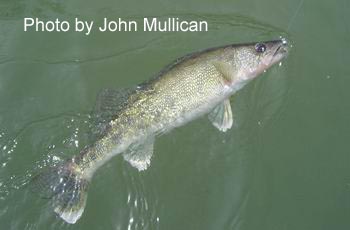 Those of us fortunate enough to be mentored in our youth by a true sportsman or learning the “be prepared” motto in Boy Scouts have lived this lesson time and again through our lives. Those of us fortunate enough to be mentored in our youth by a true sportsman or learning the “be prepared” motto in Boy Scouts have lived this lesson time and again through our lives.
Fishermen will always spend time before going fishing getting prepared, doing one’s homework, so when they do go fishing they can enjoy themselves. Few areas of a fishermen’s sporting life beg more for responsible preparation than when an angler is in the position of returning a fish unharmed back into the water. Fishermen have a responsibility to the fish, but also to other fishermen and the sport they love so much, since dead discarded fish can certainly be a problem for all.
Plan ahead
If you are going to be fishing whether it is freshwater or saltwater, most fish species are managed by seasons, size limits and creel limits. Study the rules and keep them handy for quick reference when out fishing. Keep a measuring device near by with size limits clearly and boldly marked on the ruler for quick size determination.
Be Prepared
Take a good look at your tackle and how you are going to unhook and return fish to the water. If you know that you might have to return under-sized or over the limit fish be sure to use stout tackle. It might be considered fun to catch fish on light tackle with a long fight time, but this unfortunately comes at the expense of an exhausted fish, that might not be able to recover. When fish are exercised to exhaustion, lactic acid builds up in the tissues of the fish from muscle function. This lactic acid in our own muscles is what makes us so tired from heavy exercise. In fish these increased levels of lactic acid can lead to a situation called acidosis where fish may reach a “point of no return” and can eventually die. Higher water temperatures cause this condition to be magnified and in the case of marine fish and estuarine fish, low salinities also make this situation worst. Tired and exhausted fish need lots of oxygen fast and to balance the ph of their blood. Cool, salty water is also very important to marine and estuarine fish, especially if the are large. In the case of striped bass, fish over 24” are at the greatest risk when caught and released in warm, low salinity waters. They may swim away, but studies have shown they can often die several hours later. Of the two water parameters, the water temperature is by far of the greatest importance. In a nutshell catch & release of large striped bass in waters over 70-degrees is not good. Responsible and ethical anglers will avoid this situation at all costs.
Once the fish is at the boat remember that the fish needs oxygen fast and the only way that is going to happen, is if water is flowing across the gills. Liken it to running the 200 yd. Dash and then being told to hold your breath for a minute by your coach. When a fish is brought to the boat or shore it must be unhooked and allowed to recover quickly. Things to think about are keeping the fish in the water while unhooking and making the unhooking process quick. Let’s look at some options that will speed this process.
Terminal Tackle
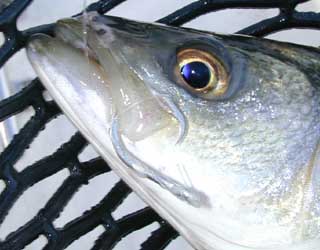 Consider squashing down the barbs on your favorite style of hooks on lures. If plugs have three sets of treble hooks, think about removing the front two and replacing the tail treble with a single hook. If you are bait fishing use circle hooks, they are a proven lifesaver for hooked fish. Set the hook immediately when using J style hooks. J style hooks when swallowed by fish can cause fatal injuries. Usually, when a fish swallows a baited hook deep into it’s stomach the action of setting the hook and reeling the fish in, will pull that hook forward. If the point of the hook is orientated ventrally or towards the belly of the fish it can cause serious and often fatal injury. The point of the hook can puncture the heart, liver or a major artery in that area. When this happens the fish bleed to death. Studies have shown that about 68% of fish hooked this way will die from trauma injuries to these organs. Hooks positioned at other angles in a fish’s stomach do not pose as much danger. Every effort should be taken to remove all fishhooks gently from fish, provided the angler has the proper tools. If the proper tools are not available for a gut hooked fish the angler is advised to cut the line and quickly return the fish to the water. The use of circle hooks solves all these problems since they almost always hook the fish in the corner of the mouth. Consider squashing down the barbs on your favorite style of hooks on lures. If plugs have three sets of treble hooks, think about removing the front two and replacing the tail treble with a single hook. If you are bait fishing use circle hooks, they are a proven lifesaver for hooked fish. Set the hook immediately when using J style hooks. J style hooks when swallowed by fish can cause fatal injuries. Usually, when a fish swallows a baited hook deep into it’s stomach the action of setting the hook and reeling the fish in, will pull that hook forward. If the point of the hook is orientated ventrally or towards the belly of the fish it can cause serious and often fatal injury. The point of the hook can puncture the heart, liver or a major artery in that area. When this happens the fish bleed to death. Studies have shown that about 68% of fish hooked this way will die from trauma injuries to these organs. Hooks positioned at other angles in a fish’s stomach do not pose as much danger. Every effort should be taken to remove all fishhooks gently from fish, provided the angler has the proper tools. If the proper tools are not available for a gut hooked fish the angler is advised to cut the line and quickly return the fish to the water. The use of circle hooks solves all these problems since they almost always hook the fish in the corner of the mouth.
Removing Hooks
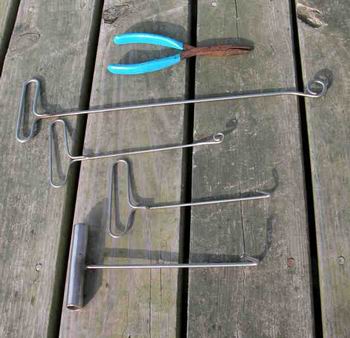 Be prepared! Have the tools you need before you go fishing and have them handy. There are many types of long nose pliers are on the market; your pocketbook only limits the choices. Pliers can mean the difference between having a hand injury and a speedy release. There are many types of dehooking tools on the market my favorites are the J style for lip hooked large fish and the Deep throat style for deep hooked fish. If you’re the least bit handy you can make a J style dehooker from a bicycle spoke and a 5-inch piece of wooden broom stick. Whatever device you choose to use, squashing the barb of the fishhook makes the whole process a lot easier. When dealing with sharks this is an absolute necessity, because of their tough mouth tissue. Kids young and old love catching sharks and since most must be returned unharmed a Deep Throat type dehooker on a long pole makes the whole process very easy. If you are unhooking fish like white perch, catfish or other prickly critters for children, you can easily just flip the fish quickly off the hook; easy for you and the fish. Freshwater fishermen and particularly trout fishermen have always liked using a pair of hemostats to remove hooks, especially flies. There are also other devices that resemble a forked stick kind of thing; they work well on deeper hooked fish. Whatever tools you choose, make sure you know how to use them and have them handy. Be prepared! Have the tools you need before you go fishing and have them handy. There are many types of long nose pliers are on the market; your pocketbook only limits the choices. Pliers can mean the difference between having a hand injury and a speedy release. There are many types of dehooking tools on the market my favorites are the J style for lip hooked large fish and the Deep throat style for deep hooked fish. If you’re the least bit handy you can make a J style dehooker from a bicycle spoke and a 5-inch piece of wooden broom stick. Whatever device you choose to use, squashing the barb of the fishhook makes the whole process a lot easier. When dealing with sharks this is an absolute necessity, because of their tough mouth tissue. Kids young and old love catching sharks and since most must be returned unharmed a Deep Throat type dehooker on a long pole makes the whole process very easy. If you are unhooking fish like white perch, catfish or other prickly critters for children, you can easily just flip the fish quickly off the hook; easy for you and the fish. Freshwater fishermen and particularly trout fishermen have always liked using a pair of hemostats to remove hooks, especially flies. There are also other devices that resemble a forked stick kind of thing; they work well on deeper hooked fish. Whatever tools you choose, make sure you know how to use them and have them handy.
Landing a Fish
 If you find that you must land a fish to control it better prior to removing hooks, use a soft small mesh net of nylon not the large mesh- size polypropylene landing nets so commonly used. This rough mesh tends to scuff off the slime on the fish, which can be very damaging to the fish, especially in warmer waters. The slime on any fish is its protection from bacteria and fungi that are very common in most waters and especially warmer waters. Striped bass in the Chesapeake Bay for example that have damaged slim layer areas can become susceptible to infections that will often show up as reddened spots or discolored areas. If a fish must be handled wet protective rubber gloves are the best, wet hands, or a wet towel are better than dry. Fishermen should also be careful not to allow themselves to be injured by fish spines. Mycobacterium or Vibrio are good examples of bacteria found in aquatic environments that can also affect humans. Placing a wet towel over their eyes and holding them down with wet gloves can calm fish. Letting a fish flop on the deck of a boat or in the dirt on the shoreline is the worst thing to do. If you find that you must land a fish to control it better prior to removing hooks, use a soft small mesh net of nylon not the large mesh- size polypropylene landing nets so commonly used. This rough mesh tends to scuff off the slime on the fish, which can be very damaging to the fish, especially in warmer waters. The slime on any fish is its protection from bacteria and fungi that are very common in most waters and especially warmer waters. Striped bass in the Chesapeake Bay for example that have damaged slim layer areas can become susceptible to infections that will often show up as reddened spots or discolored areas. If a fish must be handled wet protective rubber gloves are the best, wet hands, or a wet towel are better than dry. Fishermen should also be careful not to allow themselves to be injured by fish spines. Mycobacterium or Vibrio are good examples of bacteria found in aquatic environments that can also affect humans. Placing a wet towel over their eyes and holding them down with wet gloves can calm fish. Letting a fish flop on the deck of a boat or in the dirt on the shoreline is the worst thing to do.
Using lip gripping devices or lip gaffs with larger fish can help control fish for speedy and safe hook removal. Large fish should not be hung vertically with these devices, since internal damage can occur to the fish. Instead they should be used to control the head 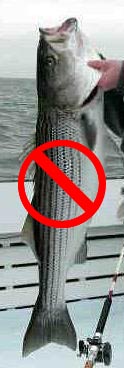 of fish and not as a lifting device. Lifting fish by the popular hand lip grip so often seen can cause damage to the jaw muscles and joints of any fish. Never hold fish up by putting your hand in the gills if they are going to be released. If posing for a picture of your catch try to cradle the fish with two hands to support the fish better. Fish grow and live in a relatively weightless of fish and not as a lifting device. Lifting fish by the popular hand lip grip so often seen can cause damage to the jaw muscles and joints of any fish. Never hold fish up by putting your hand in the gills if they are going to be released. If posing for a picture of your catch try to cradle the fish with two hands to support the fish better. Fish grow and live in a relatively weightless 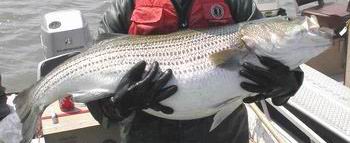 environment supported by the surrounding water. They are not used to the strains associated with being out of the water. Have the camera handy and make sure the photographer understands how to use the camera before the fish is brought to the boat or shore. Speed is the name of the game here, for the fish’s sake. Remember that statement about holding your breath after running the 200yd. Dash. When returned to the water, most exhausted fish can be held back by the tail and moved back and forth to get water moving through the gills. In the case of ram breathers such as tuna and marlin hold the fish towards the forward movement of the slow moving boat to allow water to flow through the mouth and over the gills. environment supported by the surrounding water. They are not used to the strains associated with being out of the water. Have the camera handy and make sure the photographer understands how to use the camera before the fish is brought to the boat or shore. Speed is the name of the game here, for the fish’s sake. Remember that statement about holding your breath after running the 200yd. Dash. When returned to the water, most exhausted fish can be held back by the tail and moved back and forth to get water moving through the gills. In the case of ram breathers such as tuna and marlin hold the fish towards the forward movement of the slow moving boat to allow water to flow through the mouth and over the gills.
Plan Ahead
- Know fishing regulations, minimum sizes and limits.
- Use heavy tackle and bring fish in quickly.
- Have dehookers, pliers, gloves, net, griping devices, and camera ready.
- Flatten barbs on hooks.
- Avoid catch and release of medium and large striped bass in waters warmer than 70-Degrees.
Handling Your Catch
- Keep fish in water if possible.
- Use rubber or soft mesh landing nets.
-
If you must handle fish:
- Use wet protective gloves.
- Do not lift fish vertically by jaw or gills.
- Do not allow fish flop on boat deck or ground.
- Hold fish horizontal with support.
- Return fish to water quickly.
- Removing the Hook
- Remove hook whenever possible.
- Have proper tools handy and know how to use them.
- Be quick and careful.
- Releasing the Fish
- Return fish quickly and gently.
- Move exhausted fish slowly through water to force water through the gills.
|